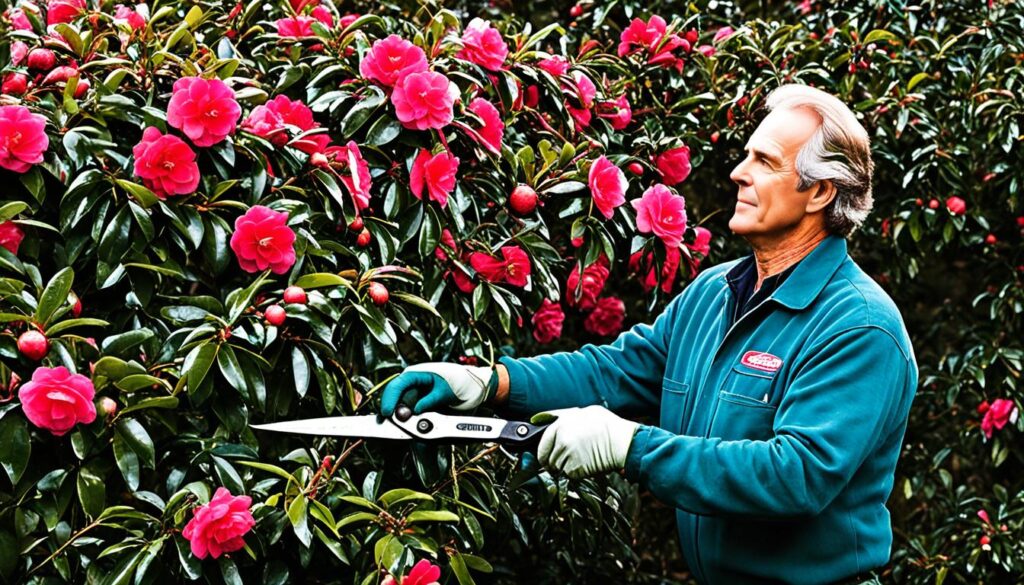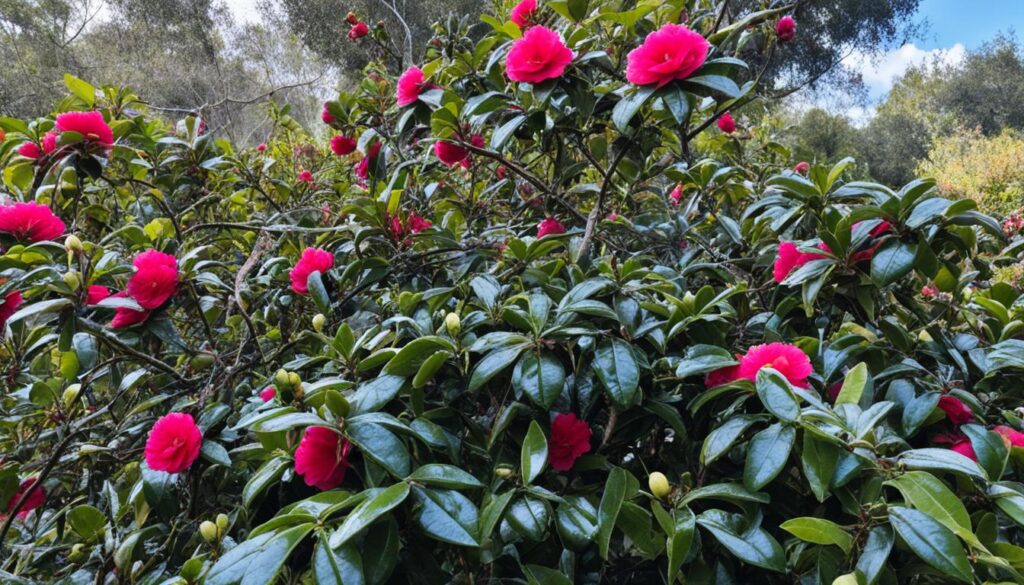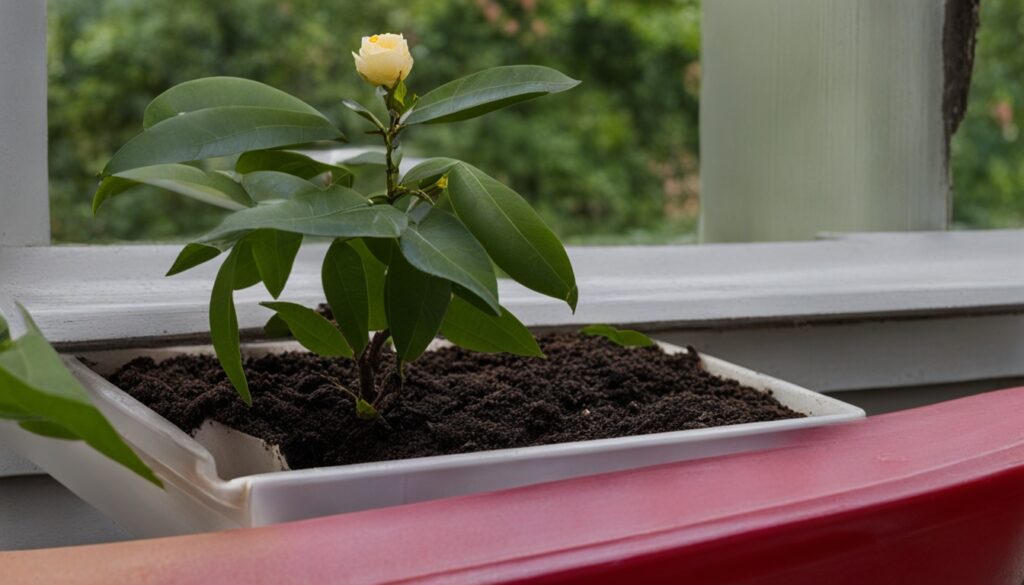Do you dream of having a garden filled with lively camellia trees? These trees have beautiful flowers and shiny, dark leaves. They make any place look stunning. By taking good care of them, you can see their colorful flowers from autumn to spring.
Camellia trees come in many sizes and shapes. They stay green all year, making them perfect for privacy, in gardens, or on their own as beautiful plants. If you’re thinking of planting them in different ways, this guide has all the advice you need. It covers planting, caring, pruning, and keeping them healthy.
But before we get into the details, here’s something interesting. Camellias aren’t just pretty trees, they’re actually related to the tea plant. Their story is really unique, and you’ll learn more about it as you read on. This guide will help you get a good grasp on growing camellia trees.
Introduction to Camellia Trees
Camellias belong to the tea family, Theaceae, and come from eastern and southern Asia. They made their way to the United States in the late 18th century. Since then, they have become a key feature in gardens across the South. There are more than 3,000 different types of camellias for gardeners to enjoy.
Origins and History of Camellia Trees
Camellias have a long history from Asia, where people loved them for their blooms and uses in tea and cosmetics. They reached the United States in the late 1700s and quickly became favorites in the South’s warm, humid weather. Today, they are still a popular choice for gardens, adding beauty and greenery all year.
Varieties of Camellia Trees
There are two main types of camellias: Camellia japonica and Camellia sasanqua. Camellia japonica has big, vibrant blooms in various colors. These include the classic red and pink, as well as white, yellow, and stripes. Camellia sasanqua, however, has smaller flowers and blooms earlier in the season, adding color to fall gardens.
Benefits of Growing Camellia Trees
Camellias aren’t just pretty; they offer many benefits for any garden. Their evergreen leaves and neat growth make excellent privacy screens and hedges. They attract pollinators like bees, butterflies, and hummingbirds with their flowers. During winter and early spring, their blooms brighten up surroundings when most plants are bare.
Growing Zones and Conditions for Camellia Trees
If you want to grow beautiful camellia trees, knowing where and how they grow best is key. Camellias do best in USDA zones 7-9, mainly in the South of the U.S. They need the right care to really shine.
These lovely evergreens like some shade, getting 2-6 hours of direct sun daily. They need soil that’s acidic, with a pH under 6.0, for the best growth and bright flowers. It’s important to shield them from strong winds, which can harm their fragile petals and leaves.
The best places for camellias are from Maryland to northern Florida and across the Carolinas, Alabama, Mississippi, and Arkansas. Giving them the perfect mix of camellia tree growing zone, USDA hardiness zones, partial shade, acidic soil, and wind protection can make your garden a thriving paradise.
Planting Camellia Trees
Planting camellia trees right means looking at where and what soil they need. The best spots and land can make your camellias bloom beautifully year after year. Just follow a few steps for success.
Choosing the Right Planting Location
Camellias like spots with some shade and a bit of direct sun each day. They also need to stay away from strong winds that might hurt them. Aim for a place that has a mix of light shade and wind cover.
Soil Requirements for Camellia Trees
Camellias do best in soil that’s rich, a bit sour, and has a pH of 5.5-6.5. If your soil is too basic, you can add peat moss to fix it. It’s essential the soil can drain well, as camellias don’t like wet feet.
Planting Instructions for Camellia Trees
When you plant, make sure the hole is much bigger than the root ball. This gives the roots plenty of room to grow. Plant the root ball a bit above ground level, with some showing. Then, put mulch around the plant but not against the trunk.
Caring for Camellia Trees
Camellia trees need the right care to stay healthy and vibrant. This includes proper watering and feeding. Let’s dive into how to care for these lovely plants.
Watering Needs for Camellia Trees
When camellias are newly planted, water them regularly. Aim for about 1 inch every week to help their roots grow strong. Once the plants are over 3 years old, they need less water. But, they should still get water in very dry weather. Use rainwater if you can. If not, water at the plant’s base to avoid wetting the leaves. This can cause fungal diseases.
Fertilizing Camellia Trees
Give your camellias an acidic fertilizer like a 12-4-8 or 10-10-10 blend. Do this in early spring, late spring, and early summer for best results. Careful not to use too much fertilizer, especially not too much nitrogen. Too much nitrogen can make leaves turn yellow and fall off.

Pruning Techniques for Camellia Trees
Camellias are low maintenance but need some care. You should prune them just after they stop blooming, which is in late spring or early summer. This way, the next year’s flowers won’t accidentally be cut off.
When to Prune Camellia Trees
The prime time for pruning camellia trees is after the blooming season, in late spring or early summer. Doing it then makes sure you won’t lose the flowers for the next year.
How to Prune Camellia Trees
Cut just above the scars from the end of the last year’s growth. This helps new buds grow. Prune to make the tree less dense, cut long stems, and take out any bad wood. Always use sharp, clean pruners to protect the plant from diseases.
| Pruning Technique | Purpose | Timing |
|---|---|---|
| Thinning | Removes dense, crowded growth to improve air circulation and light penetration | Late spring/early summer after blooming |
| Shortening Leggy Stems | Encourages more compact, bushy growth habit | Late spring/early summer after blooming |
| Removal of Damaged, Diseased or Dead Wood | Maintains plant health and appearance | Any time of year |
Protecting Camellia Trees from Pests and Diseases
Camellias face many pests and diseases. These can harm their health and look. Knowing how to spot and deal with them is key. This keeps your trees looking great and growing strong.
Common Pests Affecting Camellia Trees
Spider mites, scale insects, and aphids are big issues for camellias. They are tiny, feed on sap, and can damage your plants. They cause discoloration and slow growth. Check your plants often to keep these pests away.
Diseases Affecting Camellia Trees
Camellias can get various fungal diseases like root rot and leaf spot. These make the leaves yellow, wilt, or look ugly. To fight these, make sure your plants have good drainage and air flow. This lowers the risk of disease.
Organic and Chemical Control Methods
You can tackle pests and diseases with both natural and chemical ways. For pests, use oils, soaps, or neem oil. For bad diseases or bugs, you might need chemicals. But, use them carefully. Always read and follow the instructions to keep your camellias and the area safe.

Landscaping with Camellia Trees
Camellias are eye-catching in any garden. Their bright flowers and shiny leaves stand out. You can put one by itself or several together for a big effect.
Using Camellia Trees as Focal Points
Put camellia trees in the right place, and they really shine. They have beautiful flowers and always look green. They’re great for making doors special, adding beauty to corners, or drawing attention to spots in your garden.
Combining Camellia Trees with Other Plants
Camellias look great with plants that like the same soil, like azaleas and gardenias. Together, they make your garden look better. The dark, shiny leaves of camellias make a perfect background for these colorful plants.
Cammelias are perfect as a live fence or to hide something. They stay green all year. You get both privacy and a pretty view.
camellia tree Propagation
Growing camellias from seeds might not give you a plant like the parent one. That’s why many gardeners choose to grow them from stem cuttings instead. They do this in late spring or early summer for the best results.
Propagating Camellia Trees from Cuttings
For cutting propagation, snip 4-inch parts with 2-3 leaf sets. Next, dip the cutting ends in rooting hormone. Finally, plant them in quality well-draining soil and keep them warm, moist, and in bright, not direct sunlight. Wait for roots to grow before moving them to bigger pots or your garden.
Propagating Camellia Trees from Seeds
If you’re using seeds, collect them when the pod starts to open. Soak them before planting in a mix that’s damp and acidic. Give the seeds the right conditions, and they should start to grow for you.

Winter Care for Camellia Trees
Camellias handle cold weather well in their correct places to grow. Still, they can get hurt by too much cold, frost, and winter winds. You can help your camellias survive and do well during winter by following some important steps.
Protecting Camellia Trees from Frost
Guarding your camellias from frost is key in winter care. Wrap them with burlap or horticultural fleece to keep their flower buds safe. This stops the buds from freezing and being harmed.
Putting a layer of organic mulch near their roots helps keep them warm. For camellias in pots, move them somewhere safe, like a greenhouse or near your house. This keeps them from getting too cold and keeps the roots warm and healthy.
Troubleshooting Common Issues with Camellia Trees
Camellias can be a bit tricky, but most issues can be solved with the right care. If you see yellow leaves, your plant might need more acidic soil or more iron. You can fix this by using an acid fertilizer or an iron supplement. For bud drop, stress from drought, cold, or being moved can be the cause.
Keep the soil moist and protect the plant from severe weather. This will help it stay healthy.
Disease problems such as root rot or leaf and flower issues can happen. To lessen these risks, it’s essential to have good drainage and air flow. Also, quickly remove any parts of the plant that show signs of disease.
Good planting, watering, fertilizing, and pruning can stop many problems with camellias. By dealing with these issues with care, you can enjoy your camellia plants for a long time.



